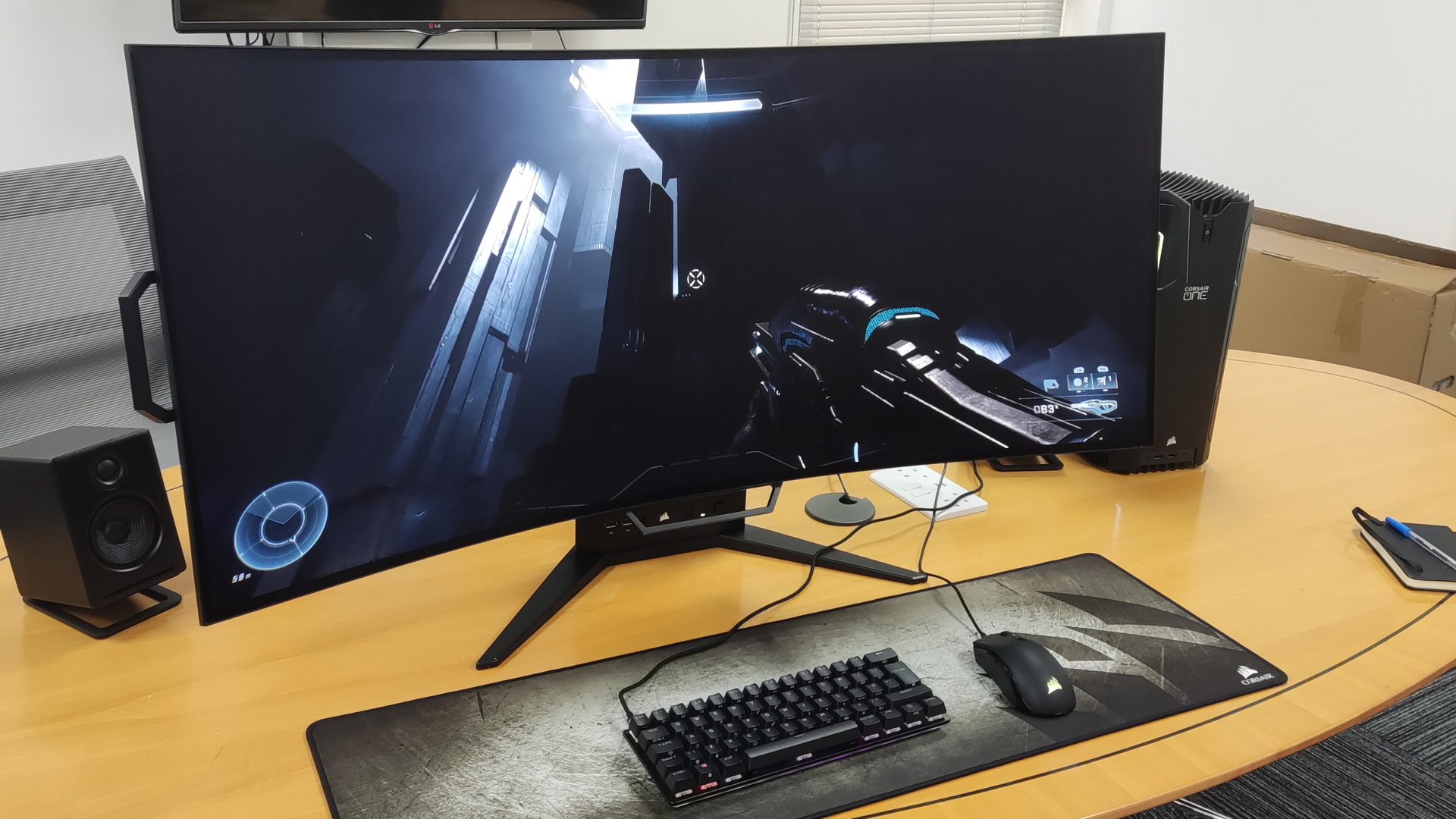As well as being faintly terrifying to flex, Corsair’s new bendy OLED gaming monitor turns out not to be the pointless MacGuffin I feared it might be. It’s still going to be seriously pricey, though.
Yes, Corsair today brought down a prototype of its Xeneon Flex (opens in new tab) OLED monitor for me to play with. That’s the one you can shift between a typical flat screen monitor and a curved one, as you see fit. This meant I could get hands-on with the device and see what the fuss was about. And as it turns out, there’s plenty here to get excited about, and not just because of that straight-to-curved gimmick, which actually may not be that gimmicky after all.
My immediate reaction to seeing the Xeneon Flex in person was surprisingly not to grab it and start bending it to my will, but rather to gawp at its LG-made OLED panel. This thing is beautiful to look at, with gorgeous contrast and colors that really pop. There’s a depth to the blacks here that make you see videos in a new light, and the likes of the latest Avatar 2 trailer look absolutely incredible.
We’ve recently seen a few OLED monitors, with Alienware’s 34 QD-OLED (opens in new tab) quickly becoming a new favorite gaming monitor in the office. And while the Corsair screen has a few more tricks up its sleeve, the fact it is built around such a strong panel is always going to be a powerful starting point.
You’re going to want to game on this monitor.
We’ve already covered the specs for Corsair’s new screen (opens in new tab), including the fact that it has a native resolution of 3440 x 1440 across its 45-inch panel, leading to a relatively low pixel density of 83ppi. That didn’t feel like a particular problem in games, although I didn’t use it much in Windows beyond launching games, which may have highlighted its shortcomings on this front more.
One thing that’s noteworthy from playing games on it is that this is a quick panel. Quite apart from the 240Hz refresh rate, which is vaguely achievable on more modest cards thanks to that native resolution, it also boasts a 0.03ms GtG response time. You can banish motion blur once and for all, basically. Unless you decide to enable it in your game of choice that is. You monster.
@pcgamer_mag (opens in new tab)
♬ Bend Me – Marletta, Luigi (opens in new tab)
Which is all fine and well, but what of its party trick? What’s it like to actually convert between a flatscreen monitor and a curved one? To start with, it’s terrifying. Even watching Corsair’s PR pull the sides forward flawlessly to bring about its super-tight 800R curve had me watching behind trembling fingers, and they’d done that countless times by that point. That didn’t stop my brain from complaining that this was clearly wrong and an abomination though.

It doesn’t take long to get a handle on exactly how much force to use though. The first bend is understandably worrying, but then you quickly get a feel for it and it becomes straightforward. Not exactly easy, because there’s a bit of your brain saying “no, no, no, stop!” but it works. There’s an audible click as you reach the full 800R bend and when you return it to flatness. The plan is to have three intermediary clicks in the shipping model as well—this here I’ve got my hands on is a prototype.
You’re not limited to the tightest curves by the way. If you want to have a subtler curve, more in the 1000R range, then you can. Just bring the sides in until you’re happy. You can curve just one side of the screen as well, which may actually work depending on your layout.
I’m not convinced either, but I’m sure there is someone out there that will want to.
This does beg the question, why do you need a screen that can be curved or flat? The idea of working in photoshop, office apps, or whatever, and then going for a more immersive curve for gaming does make sense. Driving games for instance benefit from a slight wrap-around, and even Halo Infinite felt more immersive with the sides brought in.
I’m not normally a fan of curved screens, as I play different kinds of games, and some don’t benefit from being curved. Some do, such as Cyberpunk 2077 (opens in new tab) and Apex Legends (opens in new tab), while the likes of MtG Arena (opens in new tab) and Hearthstone (opens in new tab) don’t care at all. The Xeneon Flex may actually provide that perfect solution to let me choose as needed. Provided the price is right of course.
There’s still no official word on the pricing at this point. The Xeneon Flex won’t hit the stores until the new year though, so there’s still plenty of time to sort that one out, but this is one monitor I’ll be keeping an eye on.

